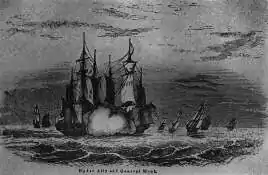Battle of Delaware Bay
The Battle of Delaware Bay, or the Battle of Cape May, was a naval engagement fought between the Kingdom of Great Britain and the United States during the American Revolutionary War. A British squadron of three vessels attacked three American privateers that were escorting a fleet of merchantmen. The ensuing combat in Delaware Bay near Cape May ended with an American victory over a superior British force.
| Battle of Delaware Bay | |||||||
|---|---|---|---|---|---|---|---|
| Part of the American Revolutionary War | |||||||
 The Hyder Ally engaging HMS General Monk | |||||||
| |||||||
| Belligerents | |||||||
|
|
| ||||||
| Commanders and leaders | |||||||
|
|
| ||||||
| Strength | |||||||
| 3 sloops-of-war |
1 frigate 1 sloop-of-war 1 brig | ||||||
| Casualties and losses | |||||||
|
4 killed 11 wounded 1 sloop-of-war captured 1 sloop-of-war damaged |
20 killed 33 wounded 1 sloop-of-war captured 1 brig grounded | ||||||
| |||||||
Background
Twenty-three-year-old Lieutenant Joshua Barney of the Continental Navy commanded the privateer sloop Hyder Ally during the battles. She was owned by Pennsylvania businessman John Willcocks and was issued a letter of marque. The sloop-of-war was armed with 16 six-pounders and had a crew of about 110 men, officers and marines, and was named after Hyder Ali, the ruler of the Kingdom of Mysore on the Indian subcontinent and a British enemy. With Lieutenant Barney were two privateer sloops: 10-gun Charming Sally and 12-gun General Greene.
Barney's first command was to escort a rebel fleet of five merchantmen to Delaware Bay. During this cruise, three British ships were sighted and a battle began. British forces included the 32-gun frigate HMS Quebec under Captain Christopher Mason, the 24-gun sloop-of-war HMS General Monk under Captain Josias Rogers, and a New York privateer brig named Fair American crewed by American loyalists. Fair American was the former American privateer General Washington, commanded by Silas Talbot at her capture.
Battle

At nightfall on April 7, 1782, the American convoy anchored within Cape May due to calm after the wind had abated. Later that night the British in Quebec and General Monk sighted the enemy fleet and anchored off the cape to make preparations to attack Hyder Ally: she was considered the most formidable ship of the fleet. Unaware of the British vessels nearby, the Americans spent the night believing they were safe. The following morning three British privateers were spotted and Captain Mason signaled them to join him; only Fair American responded. At 10:00 am the Americans sighted the British vessels approaching. Lieutenant Barney ordered the merchantmen to flee up Delaware Bay under the protection of General Greene and Charming Sally, while Hyder Ally remained behind to engage the British.
The fleet was directed to sail as close to the shoreline as possible so as to disallow pursuit. The larger British vessels would have difficulty following in the shallow water. General Greene disobeyed Barney's orders and prepared for battle. Charming Sally grounded on a shoal and was abandoned by her crew. At about 11:00 am the three British vessels were identified by the Americans. Quebec stood off nearby Cape Henlopen to prevent the Americans from escaping Cape May into the Atlantic, but this was unnecessary as the Americans were headed into the bay rather than into open sea. Fair American led the advance with General Monk behind. Sometime after noon the British came within range of the two American privateers. To try to lure General Monk closer, Lieutenant Barney turned about as if attempting to flee. Fair American opened fire with a broadside followed by another; the shots were accurate but caused little damage.
Still in a fake retreat, Hyder Ally's gun ports remained closed and no shots had yet been fired by the Continentals. General Greene did the same as Hyder Ally and turned around, but she grounded just outside British gun range. The trick had worked: Fair American broke off the effort to attack General Greene as General Monk proceeded forward to attack Hyder Ally. Fortunately for Continental forces, Fair American grounded in shallow water and was put out of the action permanently because of damage to her hull. Heading forward, Captain Rodgers decided to slow down and launch a boat to take the abandoned Charming Sally, after which he continued on until he caught up with Hyder Ally. When within range of pistols, Rodgers ordered her to surrender. Barney answered with a broadside of grape, canister and round shot that raked the deck of the British sloop, killing some sailors and marines. General Monk replied with her bow guns, which were the only weapons bearing down on the Americans at the time.

Barney ordered his ship to port and unleashed another broadside whose shots passed through the sails and rigging of General Monk and damaged her main and top-gallant masts. Before the battle the British bored their six-pounders on General Monk to fire nine-pound balls. This proved fatal when the British came within a few yards off Hyder Ally's beam for a full broadside of their own. When they fired, General Monk's cannons were torn up from the deck and flipped over. Several sailors burned themselves as they tried to right the cannons.
A few minutes later the two sloops had drifted close enough to each other that the British and Americans could hear each other shouting commands. Barney took the opportunity to reload his cannon but he did not give his gunners the order to open fire. Instead the lieutenant shouted "hard a-port, do you want him to run abroad of us?" another trick. Hearing this, Captain Rodgers ordered his ship to port as Lieutenant Barney ordered his vessel to starboard.
As a result, the two vessels collided and became entangled in each other's rigging. The American sailors fastened General Monk to their ship to prevent her from breaking loose and then fired their broadside. The shots knocked out some of the British guns and sent the crew into confusion. The American marines sat high in the rigging of Hyder Ally and poured musket fire into the British. Barney's men boarded while he remained on top of the compass box to direct the attack. About this time the box was shot out from under the lieutenant but he suffered only a slight injury. Barney also ordered that his port-side guns be turned around to the starboard so they could assist in the battle. After only 26 minutes of close-quarters combat, Captain Rodgers was wounded and all of his officers were killed except a midshipman who struck the colors.
A total of 20 Britons died and 33 were wounded. General Monk was captured and Fair American was aground and stranded, so Captain Mason in Quebec fled without actually engaging in the fight. American forces suffered the loss of four killed and 11 wounded. Charming Sally was captured without a fight, Hyder Ally was damaged considerably, and General Greene was grounded but re-floated after Quebec began her retreat.
Aftermath
The Americans won the day and Lieutenant Joshua Barney was given command of the prize General Monk, which had well over 300 shot-holes in her sides. Barney sailed both Hyder Ally and Monk to Chester, Pennsylvania, where he left Hyder Ally and sailed on to Philadelphia in Monk.[1] He was then ordered to France to deliver dispatches to Benjamin Franklin. After the war ended Barney joined the French Navy. During the War of 1812, Barney was a captain, commanded the Chesapeake Bay Flotilla, and later commanded marines and sailors at the Battle of Bladensburg.
Order of battle
Continental Navy:
- Hyder Ally, sloop-of-war, flagship
- Charming Sally, sloop-of-war
- General Greene, sloop-of-war
Royal Navy:
- HMS Quebec, frigate, flagship
- HMS General Monk, sloop-of-war
- Fair American, brig
See also
Citations
- Ashmead, Henry Graham (1883). Historical Sketch of Chester, on Delaware. Chester, PA: Republican Steam Printing House. p. 32. Retrieved 29 April 2018.
References
- Brewington, Myron V. (1939) The Battle of Delaware Bay, 1782. (U.S. Naval Institute). ASIN B0008BW3TM
- The United States' naval chronicle, Volume 1
- Joshua Barney: hero of the Revolution and 1812
- Hazard's Register of Pennsylvania, Volumes 9-10